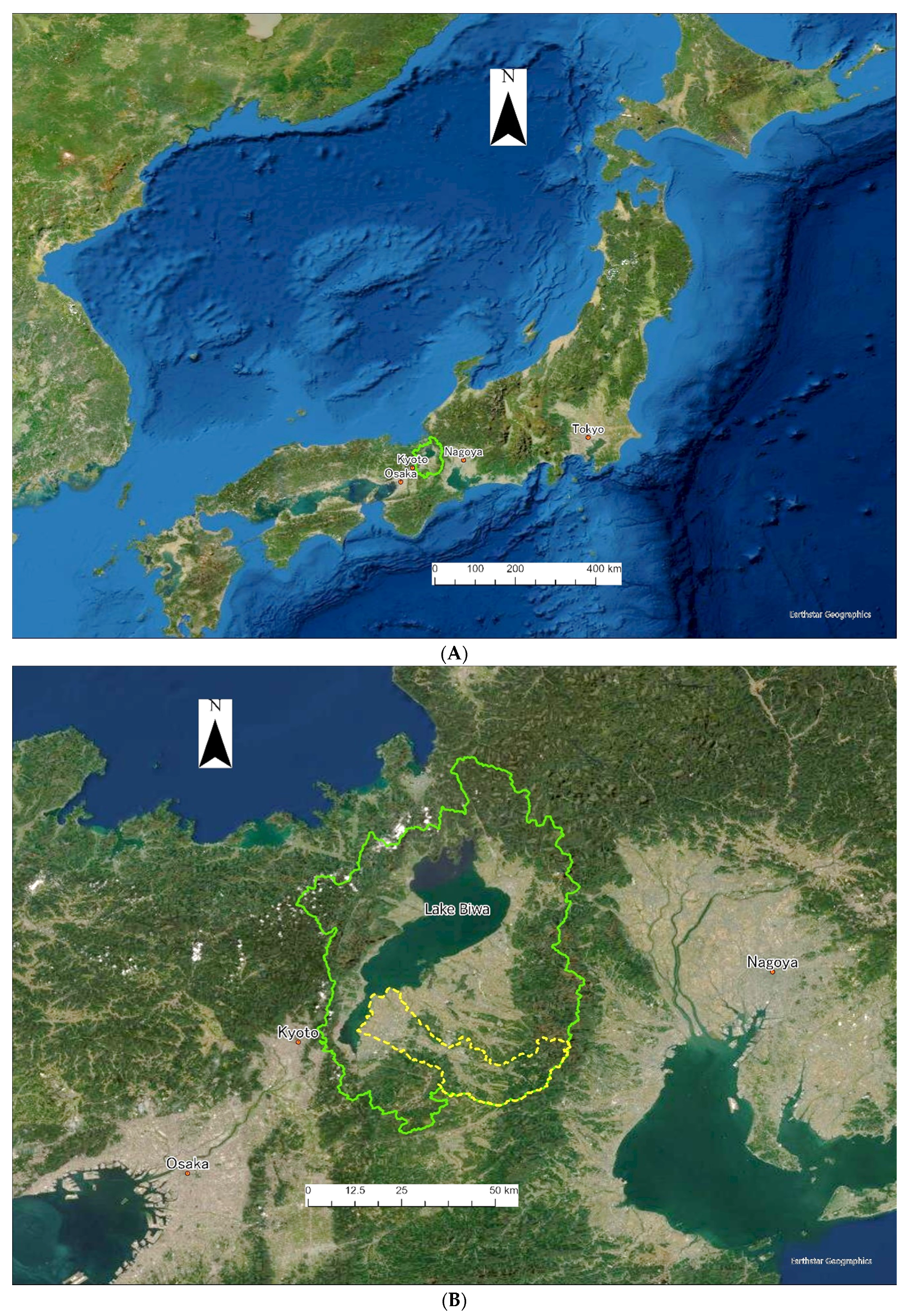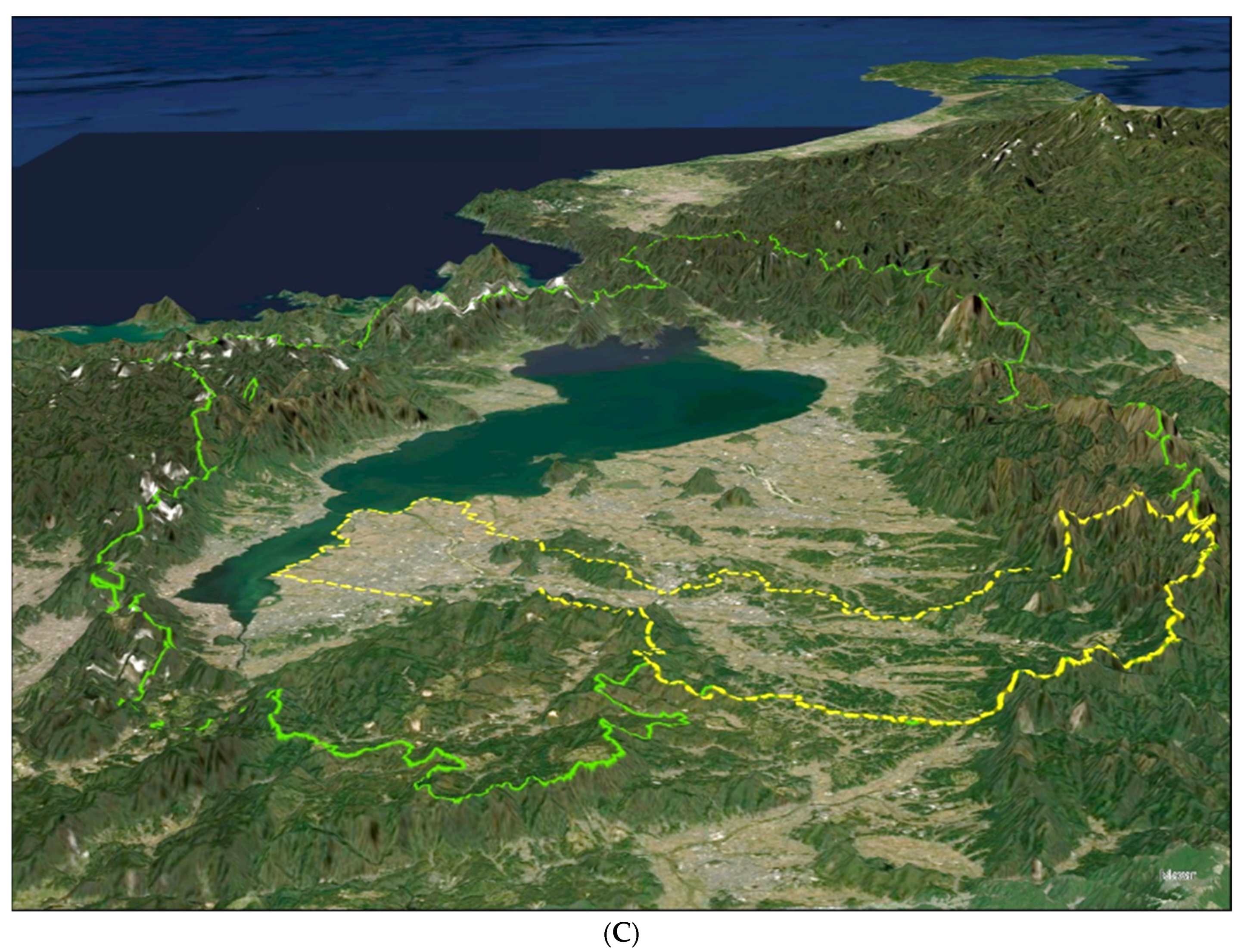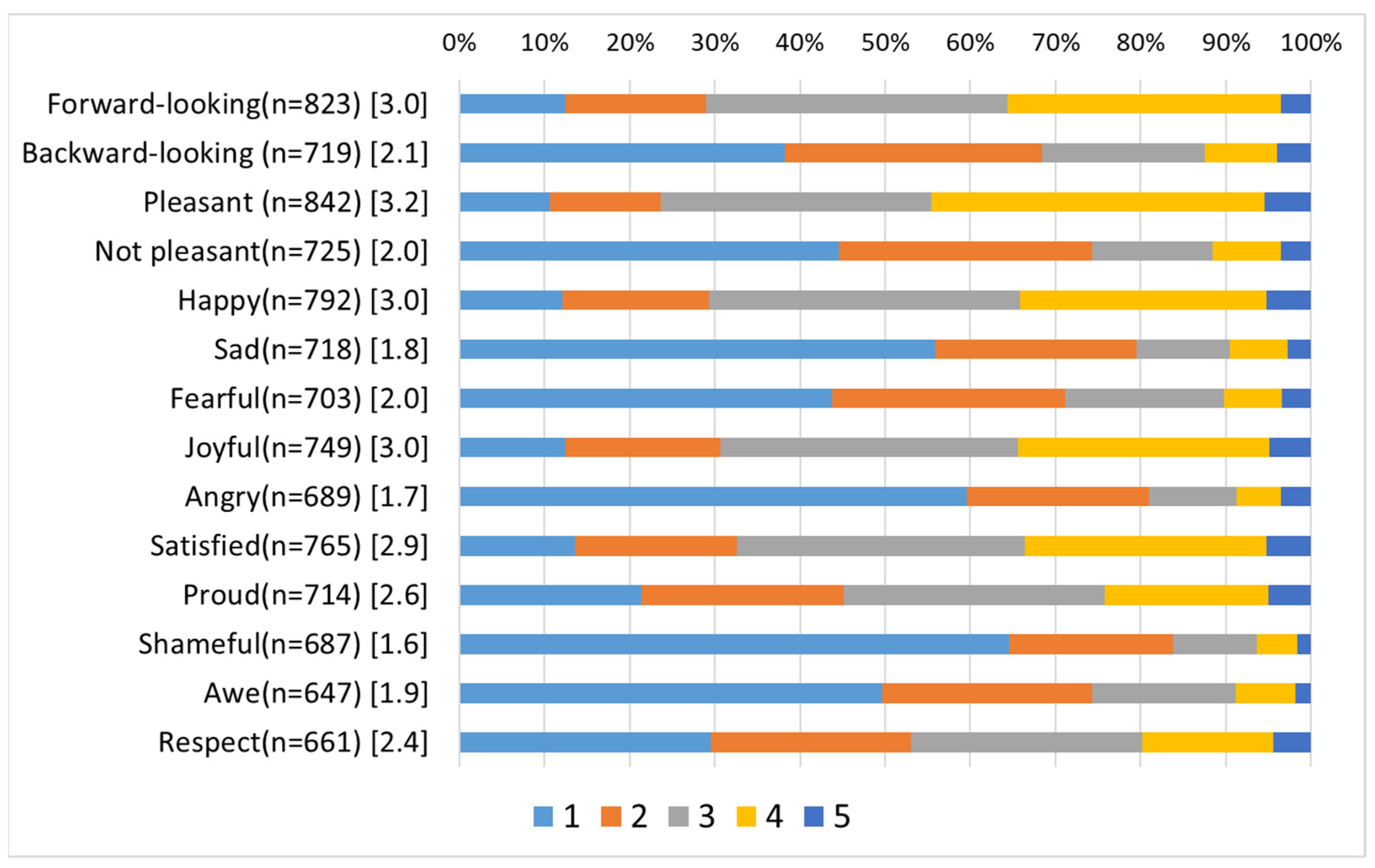Subjective Well-Being as a Potential Policy Indicator in the Context of Urbanization and Forest Restoration
Abstract
1. Introduction
1.1. Background
1.2. Subjective Well-Being as a Policy Indicator
1.3. SWB-Correlated Factors in the Literature
1.4. Natural Capital
1.5. Built or Manufactured Capital
1.6. Human Capital/Social or Cultural Capital
1.7. Demographic Factors
1.8. Methodologies
1.9. Structure of Paper
2. Study of Forest SWB across the Entire Yasu Watershed (Study 1)
- Subjective health (dependent variable 1–explanatory variable 1; 1–1) and age squared (1–2) were positively correlated with forest SWB.
- The professional category of respondents was also associated with forest SWB such that individuals working in forestry (1–4) and fishery (1–5) had higher forest SWB and those working in businesses (1–10) had lower forest SWB relationships.
- Engagement with wildlife (1–9) and recreational activities (e.g., leisure) (1–7) had positive relationships with forest SWB.
- There was a significant interaction between the ratio of forest ratios and forest-related activities (1–12) predicting forest SWB. This indicates that respondents who lived in forested areas perceived lower forest SWB from forest-related activities than did those in less forested areas.
- The forest ratios of the respective postal areas where respondents resided did not correlate with forest SWB.
3. Study of Forest SWB within the Upper Yasu Watershed (Study 2)
- Subjective health was positively correlated with forest SWB (2–1, 3–1, 4–1, 5–1).
- Female respondents were more likely to report higher forest SWB (2–3, 5–2, 6–1).
- Age correlated with forest SWB (2–2, 2–8). As the age terms and the age squared had negative and positive coefficients, respectively, in the “2 Feeling regarding local forests” analysis for the upper watershed survey, age and forest SWB had a curvilinear, U-shaped relationship with the lowest point at a positive age. The authors determined that the age of 53 had the lowest point.
- Respondent jobs had positive and negative relationships with forest SWB. Individuals working in forestry (4–4) and agriculture (3–2, 4–3) had positive relationships, while those working in business (2–9) and studying at school (2–11, 3–6, 4–9) had negative relationships.
- Observing animals and plants (5–6, 6–4) had a positive relationship with forest SWB.
- Recreational activities, such as climbing/skiing (3–3, 4–5, 5–5, 6–2), and fishing/collecting mountain vegetables (2–7, 3–4, 6–3) were positively related to forest SWB.
- Management of privately owned forests (3–5, 4–6) had a positive relationship with forest SWB, and management of community forests (5–9) had a negative relationship.
- Ownership of forests (2–12, 3–7, 4–10, 5–10, 6–6) was negatively related to forest SWB.
- The forest ratios of the respective postal areas where the respondents resided did not correlate with the forest SWB.
4. Discussion
4.1. Rationales for Forest SWB as a Policy Indicator
4.2. Possibilities and Challenges for Forest SWB
5. Conclusions
Author Contributions
Funding
Institutional Review Board Statement
Informed Consent Statement
Data Availability Statement
Acknowledgments
Conflicts of Interest
References
- United Nations, Department of Economic and Social Affairs, P.D. World Urbanization Prospects: The 2018 Revision (ST/ESA/SER.A/420); United Nations: New York, NY, USA, 2019; pp. 1–103. [Google Scholar]
- Mather, A.S. The forest transition. Area 1992, 24, 367–379. [Google Scholar]
- Mather, A.; Needle, C.L. The forest transition: A theoretical basis. Area 1998, 30, 117–124. [Google Scholar] [CrossRef]
- MacDonald, H.; McKenney, D. Envisioning a global forest transition: Status, role, and implications. Land Use Policy 2020, 99, 104808. [Google Scholar] [CrossRef]
- Ota, T. Forest Saturation: Thinking about Changing National Land; NHK Publishing: Tokyo, Japan, 2012; pp. 1–254. [Google Scholar]
- Weible, C.M.; Sabatier, P.A. (Eds.) Theories of the Policy Process; Westview Press: New York, NY, USA, 2018; pp. 1–416. [Google Scholar]
- IPBES. Summary for Policymakers of the Global Assessment Report on Biodiversity and Ecosystem Services of the Intergovernmental Science-Policy Platform on Biodiversity and Ecosystem Services; Díaz, S., Settele, J., Brondízio, E.S., Ngo, H.T., Guèze, M., Agard, J., Arneth, A., Balvanera, P., Brauman, K.A., Butchart, S.H.M., et al., Eds.; IPBES: Bonn, Germany, 2019; pp. 1–45. [Google Scholar]
- Ministry of Agriculture, Forestry and Fisheries. National Forest Plan (Approved by the Cabinet on October 16, 2018); Ministry of Agriculture, Forestry and Fisheries: Tokyo, Japan, 2018; pp. 1–30.
- Akiyama, T. Attitudes of members of forest owner’s associations toward forestry and challenges for the associations: Based on the result of questionnaire surveys. Financ. Agric. For. 2008, 61, 27–41. [Google Scholar]
- Forestry Agency. White Paper of Forests and Forestry (Heisei 29 (2017)); Forestry Agency: Tokyo, Japan, 2018; pp. 1–246.
- FAO. Global Forest Resources Assessment 2015 (FRA 2015); FAO: Rome, Italy, 2015; pp. 1–244. [Google Scholar]
- Eid, M.; Larsen, R.J. (Eds.) The Science of Subjective Well-Being; The Guilford Press: New York, NY, USA, 2008; pp. 1–546. [Google Scholar]
- Diener, E. Subjective well-being: The science of happiness and a proposal for a national index. Am. Psychol. 2000, 55, 34–43. [Google Scholar] [CrossRef]
- Diener, E.; Lucas, R.E.; Oishi, S. Subjective well-being: The science of happiness and life satisfaction. In Handbook of Positive Psychology; Snyder, C.R., Lopez, S.J., Eds.; Oxford University Press: Oxford, UK, 2002; pp. 63–73. [Google Scholar]
- Kahneman, D.; Wakker, P.; Sarin, R. Back to Bentham? Explorations of experienced utility. Quart. J. Econ. 1997, 112, 375–405. [Google Scholar] [CrossRef]
- Frey, B.S.; Stutzer, A. What can economists learn from happiness research? J. Econ. Lit. 2002, 40, 402–435. [Google Scholar] [CrossRef]
- Dolan, P.; Peasgood, T.; White, M. Do we really know what makes us happy? A review of the economic literature on the factors associated with subjective well-being. J. Econ. Psychol. 2008, 29, 94–122. [Google Scholar] [CrossRef]
- Millennium Ecosystem Assessment. Millennium Ecosystem Assessment. Available online: https://www.millenniumassessment.org/en/Global.html (accessed on 2 July 2020).
- Costanza, R.; de Groot, R.; Braat, L.; Kubiszewski, I.; Fioramonti, L.; Sutton, P.; Farber, S.; Grasso, M. Twenty years of ecosystem services: How far have we come and how far do we still need to go? Ecosyst. Serv. 2017, 28, 1–16. [Google Scholar] [CrossRef]
- Kopmann, A.; Rehdanz, K. A human well-being approach for assessing the value of natural land areas. Ecol. Econ. 2013, 93, 20–33. [Google Scholar] [CrossRef]
- Ambrey, C.L.; Fleming, C.M. Valuing Ecosystem Diversity in South East Queensland: A Life Satisfaction Approach. Soc. Indic. Res. 2014, 115, 45–65. [Google Scholar] [CrossRef]
- Ambrey, C.L.; Fleming, C.M. Valuing scenic amenity using life satisfaction data. Ecol. Econ. 2011, 72, 106–115. [Google Scholar] [CrossRef]
- Bertram, C.; Rehdanz, K. The role of urban green space for human well-being. Ecol. Econ. 2015, 120, 139–152. [Google Scholar] [CrossRef]
- Krekel, C.; Kolbe, J.; Wüstemann, H. The greener, the happier? The effect of urban land use on residential well-being. Ecol. Econ. 2016, 121, 117–127. [Google Scholar] [CrossRef]
- Tsurumi, T.; Managi, S. Environmental value of green spaces in Japan: An application of the life satisfaction approach. Ecol. Econ. 2015, 120, 1–12. [Google Scholar] [CrossRef]
- Tsurumi, T.; Imauji, A.; Managi, S. Greenery and Subjective Well-being: Assessing the Monetary Value of Greenery by Type. Ecol. Econ. 2018, 148, 152–169. [Google Scholar] [CrossRef]
- Kunugi, Y.; Arimura, T.H.; Nakashizuka, T.; Oguro, M. Subjective well-being and natural capital in Japan—An empirical analysis using micro data. Environ. Sci. 2017, 30, 96–106. [Google Scholar]
- Holmes, T.; Koch, F. Bark Beetle epidemics, life satisfaction, and economic well-being. Forests 2019, 10, 696. [Google Scholar] [CrossRef]
- Jang, Y.-S.; Yoo, R.-H.; Lee, J.-H. The Effects of Visit Characteristics in Neighborhood Forest on Individual Life Satisfaction. J. People Plants Environ. 2019, 22, 677–690. [Google Scholar] [CrossRef]
- Lafortezza, R.; Giuseppe Carrus, G.; Sanesi, G.; Clive Davies, C. Benefits and well-being perceived by people visiting green spaces in periods of heat stress. Urban For. Urban Green. 2009, 8, 97–108. [Google Scholar] [CrossRef]
- Carrus, G.; Scopelliti, M.; Lafortezza, R.; Colangelo, G.; Ferrini, F.; Salbitano, F.; Agrimi, M.; Portoghesi, L.; Semenzato, P.; Sanesi, G. Go greener, feel better? The positive effects of biodiversity on the well-being of individuals visiting urban and peri-urban green areas. Landsc. Urban Plan. 2015, 134, 221–228. [Google Scholar] [CrossRef]
- Bieling, C.; Plieninger, T.; Pirker, H.; Vogl, C.R. Linkages between landscapes and human well-being: An empirical exploration with short interviews. Ecol. Econ. 2014, 105, 19–30. [Google Scholar] [CrossRef]
- Lee, W.H.; Ambrey, C.; Pojani, D. How do sprawl and inequality affect well-being in American cities? Cities 2018, 79, 70–77. [Google Scholar] [CrossRef]
- MacKerron, G.; Mourato, S. Happiness is greater in natural environments. Glob. Environ. Chang. 2013, 23, 992–1000. [Google Scholar] [CrossRef]
- Wei, H.; Hauer, R.J.; Chen, X.; He, X. Facial expressions of visitors in forests along the urbanization gradient: What can we learn from selfies on social networking services? Forests 2019, 10, 1049. [Google Scholar] [CrossRef]
- Takahashi, T.; Asano, S.; Uchida, K.; Takemura, K.; Fukushima, S.; Matsushita, K.; Okuda, N. Effects of forests and forest-related activities on the subjective well-being of residents in a Japanese watershed: An econometric analysis through the capability approach. For. Policy Econ. 2021. under review. [Google Scholar]
- Ministry of Land, Infrastructure, Transport and Tourism. I.Land and Climate of Japan. Available online: https://www.mlit.go.jp/river/basic_info/english/land.html (accessed on 2 November 2020).
- Takahashi, T. Attitudes of Residents in the Southern Shiga Watershed toward Forests: Investigation of its Structure based on a Questionnaire Survey. J. Rural Probl. 2009, 45. [Google Scholar] [CrossRef][Green Version]
- Shiga Prefecture. Statistical Book of Shiga Prefecture. 2018. (Siga ken toukeisyo, Heisei 30 nendo, 2018 nendo); Shiga Prefecture: Otsu, Japan, 2020.
- Ministry of Internal Affaiirs and Communication. National Census 2015; Ministry of Internal Affaiirs and Communication: Tokyo, Japan, 2017.
- Naumann, N. Yama no Kami (Yama no Kami: Die japanische Berggottheit); Gensosha: Tokyo, Japan, 1994. [Google Scholar]
- Takahashi, T.; Uchida, Y.; Ishibashi, H.; Okuda, N. Factors affecting forest-related subjective well-being: A case study in the upper Yasu River watershed. J. Jpn. For. Soc. 2021, 103. in press. [Google Scholar]
- OECD. OECD Guidelines on Measuring Subjective Well-being; OECD Publishing: Paris, France, 2013; pp. 1–265. [Google Scholar]
- Ryff, C.D.; Keyes, C.L.M. The structure of psychological well-being revisited. J. Pers. Soc. Psychol. 1995, 69, 719. [Google Scholar] [CrossRef] [PubMed]
- Aristotle. Aristotle’s Nicomachean Ethics; The University of Chicago Press: Chicago, IL, USA, 2011. [Google Scholar]
- Forestry Agency. White Paper of Forests and Forestry (Reiwa 1 (2019)); Forestry Agency: Tokyo, Japan, 2020.
- IPBES. Report of the Plenary of the Intergovernmental Science-Policy Platform on Biodiversity and Ecosystem Services on the Work of Its Seventh Session; IPBES: Bonn, Germany, 2019. [Google Scholar]
- Biedenweg, K.; Gross-Camp, N.D. A brave new world: Integrating well-being and conservation. Ecol. Soc. 2018, 23, 1–4. [Google Scholar] [CrossRef]
- Woodhouse, E.; Homewood, K.M.; Beauchamp, E.; Clements, T.; McCabe, J.T.; Wilkie, D.; Milner-Gulland, E.J. Guiding principles for evaluating the impacts of conservation interventions on human well-being. Philos. Trans. R. Soc. B Biol. Sci. 2015, 370. [Google Scholar] [CrossRef]
- Cooper, N.A.; Kainer, K.A. To log or not to log: Local perceptions of timber management and its implications for well-being within a sustainable-use protected area. Ecol. Soc. 2018, 23. [Google Scholar] [CrossRef]
- Duchelle, A.E.; de Sassi, C.; Jagger, P.; Cromberg, M.; Larson, A.M.; Sunderlin, W.D.; Atmadja, S.S.; Resosudarmo, I.A.P.; Pratama, C.D. Balancing carrots and sticks in REDD+: Implications for social safeguards. Ecol. Soc. 2017, 22. [Google Scholar] [CrossRef]
- Centre for Bhutan Studies. A Compass Towards a Just and Harmonious Society 2015 GNH Survey Report; Centre for Bhutan Studies: Timphu, Bhutan, 2016; pp. 1–334. [Google Scholar]
- Centre for Bhutan Studies; GNH. Happiness: Tranforming the Development Landscape; Centre for Bhutan Studies: Timphu, Bhutan, 2017; pp. 1–475. [Google Scholar]





| Chapters | Subchapters |
|---|---|
| I. Goals and other basic issues | 1 Principles of forest management and protection |
| 2 Goals of forest management and protection | |
| II. Forest management | 1 Harvesting/planting and thinning/tending |
| 2 Publicly beneficial forests | |
| 3 Forest road construction and transportation of forest products | |
| 4 Rationalization of forest management | |
| III. Forest protection | 1 Forest land protection |
| 2 Facilities | |
| 3 Protection from pests and fires | |
| IV. Improvement of health-enhancing function of forests | 1 Principles of setting up forests for health-enhancing function |
| 2 Principles of management of forests for health-enhancing function | |
| 3 Other necessary issues |
| TOPIC/Variable |
|---|
| Extent Area |
| Forest area |
| Other wooded land |
| Other land |
| of which with tree cover |
| Forest Characteristics |
| Primary forest |
| Other naturally regenerated forest |
| Planted forest |
| Area of mangrove forest |
| Growing Stock, Biomass and Carbon |
| Forest growing stock |
| Above-ground biomass |
| Below-ground biomass |
| Dead wood |
| Carbon in above-ground biomass |
| Carbon in below-ground biomass |
| Carbon in dead wood |
| Carbon in litter |
| Soil carbon |
| Production and Multiple use |
| Production forest |
| Multiple use forest |
| Biodiversity and Protected Areas |
| Conservation of biodiversity |
| Forest area within protected areas |
| Ownership of Forests |
| Public ownership |
| Private ownership |
| Unknown ownership |
| Management Rights of Public Forests |
| Public administration |
| Individuals |
| Private companies |
| Communities |
| Other |
| Employment in Forestry |
| Employment in forestry |
| Topics | Descriptions |
|---|---|
| Coverage and size | The Yasu River tributary to Lake Biwa, the largest lake in Japan, is 65.3 km long with a watershed area of 387.0 km2. |
| Society and economy | The watershed covers six municipalities with a combined population of 479,000 in 2015. The downstream areas consist of urban/rural mixed land with thriving commercial and industrial sections that capitalize on the advantages of the major railroads and motorways connecting the eastern and western areas of the country. The upstream areas are also urbanized to a lesser extent; most of this area is rural, with forestry (timber production) activities occurring within. |
| Forests | The total forested area in the six cities consists of 39,902 ha, comprising 51% of the total land area, while the forest ratios range from 6% to 55% among the six cities. 49% are plantation forests, and the ratios of plantation forests among the six cities vary from 0% to 67%. Forests owned by households are the largest category in terms of ownership (44%), followed by corporate (7%), and national forests (7%) in the six cities. The forests in the watershed are classified as temperate and are composed of (i) plantation forests dominated by Japanese cedar (Cryptomeria japonica) and cypress (Chamaecyparis obtusa), and (ii) natural forests dominated by konara oak (Quercus serrata). |
| Dependent Variables | Explanatory Variables: Positive Coefficients | Explanatory Variables: Negative Coefficients |
|---|---|---|
| Entire Watershed | ||
| 1 Feeling regarding local forests | 1 Subjective health 2 Age (squared) 3 Social interaction 4 Working in forestry 5 Working in fishery 6 School education level 7 Leisure activities in forests 8 Seeing forests from homes 9 Engagement with wildlife | 10 Working in business 11 No engagement with forests 12 Interaction terms between forest ratios and forest-related activities (leisure, observing from home, and engagement with wildlife) |
| (no relation found) Areal ratio of forests in the area the respondent lives Areal ratios of natural or plantation forests in the area the respondent lives | ||
| Dependent Variables | Explanatory Variables: Positive Coefficients | Explanatory Variables: Negative Coefficients |
|---|---|---|
| Upper watershed | ||
| 2 Feelings regarding local forests | 1 Subjective health 2 Age (squared) 3 Female 4 Number of family members 5 School education level 6 Social interaction within local community 7 Fishing/collecting mountain vegetables | 8 Age 9 Working in business 10 Part-time job 11 Student 12 Ownership of forests |
| 3 Forest satisfaction | 1 Subjective health 2 Working in agriculture 3 Climbing/skiing 4 Fishing/collecting mountain vegetables 5 Management of privately owned forest | 6 Student 7 Ownership of forests |
| 4 Forest fulfillment | 1 Subjective health 2 Working as a civil servant 3 Working in agriculture 4 Working in forestry 5 Climbing/skiing 6 Management of privately owned forest 7 Management of forests as a volunteer | 8 Female 9 Student 10 Ownership of forests |
| 5 Positive affect | 1 Subjective health 2 Female 3 Interaction with community members 4 Camping 5 Climbing/skiing 6 Observing animals and plants 7 Wood-working | 8 Part-time job 9 Management of community forests 10 Ownership of forests |
| 6 Negative affect ** | 1 Female 2 Climbing/skiing 3 Fishing/collecting mountain vegetables 4 Observing animals and plants 5 Plantation ratio of forests owned | 6 Ownership of forests |
| All five dependent variables | (No relation found) Areal ratio of forests in the area the respondent lives | |
Publisher’s Note: MDPI stays neutral with regard to jurisdictional claims in published maps and institutional affiliations. |
© 2021 by the authors. Licensee MDPI, Basel, Switzerland. This article is an open access article distributed under the terms and conditions of the Creative Commons Attribution (CC BY) license (http://creativecommons.org/licenses/by/4.0/).
Share and Cite
Takahashi, T.; Uchida, Y.; Ishibashi, H.; Okuda, N. Subjective Well-Being as a Potential Policy Indicator in the Context of Urbanization and Forest Restoration. Sustainability 2021, 13, 3211. https://doi.org/10.3390/su13063211
Takahashi T, Uchida Y, Ishibashi H, Okuda N. Subjective Well-Being as a Potential Policy Indicator in the Context of Urbanization and Forest Restoration. Sustainability. 2021; 13(6):3211. https://doi.org/10.3390/su13063211
Chicago/Turabian StyleTakahashi, Takuya, Yukiko Uchida, Hiroyuki Ishibashi, and Noboru Okuda. 2021. "Subjective Well-Being as a Potential Policy Indicator in the Context of Urbanization and Forest Restoration" Sustainability 13, no. 6: 3211. https://doi.org/10.3390/su13063211
APA StyleTakahashi, T., Uchida, Y., Ishibashi, H., & Okuda, N. (2021). Subjective Well-Being as a Potential Policy Indicator in the Context of Urbanization and Forest Restoration. Sustainability, 13(6), 3211. https://doi.org/10.3390/su13063211






